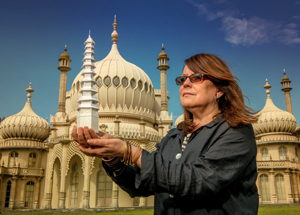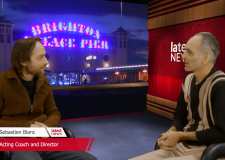Be dazzled, opulence at Brighton’s Royal Pavilion
Pavilion Contemporary pays homage to opulence at Brighton’s Royal Pavilion
The Lost Pagodas mark the launch of Pavilion Contemporary, a major three year initiative at the Royal Pavilion. Internationally acclaimed artist Geraldine Pilgrim has created a series of site-specific installations around the palace which echo visually the essence of the Pavilion’s spirit – opulence, with a hint of naughtiness – and celebrate George IV’s passions for food, music and love. These installations take the form of four stunning new pagodas which will entrance visitors with music, light, reflections and delicate lace patterning. They are in situ for six months.

The pagoda represented the high point of ‘chinoiserie’ taste in England: among George IV’s extravagant commissions for his royal residence were six gilded porcelain pagodas, made to dazzle his guests in the Music Room. These three-dimensional pagodas stood against the rich red wall panels, embellished with painted gold pagodas and Chinese scenes. The originals now form part of the Royal Collection at Buckingham Palace, moved there by Queen Victoria in the 1840s. However, two magnificent ceramic pagodas similar to the original creations were purchased by the Royal Pavilion in 1950.
Geraldine Pilgrim has won acclaim for her site-specific installations that respond to the architecture and history of buildings and abandoned, ancient sites. She was intrigued by the story of the porcelain pagodas and has created installations that temporarily replace the ‘lost’ four.
These highly imaginative contemporary art works – Sparkle, Reflection, Chaser and Translucence – enhance their exotic context and should not be missed.
In the Long Gallery, which runs between the Music Room and the Banqueting Room, Sparkle is a crystal pagoda chandelier, built on a brass-wired frame trimmed with crystals, drops and chains. Alternate layers are lit by six chandelier-sized lights, one on each point of the ‘roofs’, and on the ‘rooftop’ a purpose-built chandelier with 12 arms creates a full chandelier effect. This is a most appropriate pagoda for the richly decorated Long Gallery, which shows off decorative tricks so characteristic of the Pavilion: imitation bamboo, brightly painted lanterns, painted windows, and carefully placed mirrors reflecting images across the room. When mirror-backed doors at each end were closed, ‘an almost magical illusion [was] produced, the perspective appearing interminable’.

Reflection, in the Great Kitchen, is a splendid structure inspired by reflections from the magnificent set of copperware pans on display. It consists of nine mirrored sections, each layer bearing heaps of gleaming cutlery. George IV would have approved of this pagoda, as he was delighted with the design and equipment of his new kitchen – one of the most innovative of its time. He would escort guests into the Great Kitchen as a continuation of their tour of the Pavilion’s public apartments.
In the Music Room, Chaser is a multi-coloured pagoda, with inbuilt miniature carousels, trimmed with traditional fairground lights, timed so that they slowly turn on a revolve to the sound of fairground music. This would have appealed greatly to George IV also, as one of his great passions was music. The King’s own band entertained guests in the Music Room, and King George would often contribute to the evening’s entertainment with popular airs, accompanying himself on the pianoforte.
Translucence, in the first floor North Gallery, is a pagoda with lace stretched taut over the metal framework, and delicate patterning at each level. It is lit within by blue light, creating a translucent, ethereal lace effect, and shadows echoing the decor of this space. The North Gallery was used as a breakfast room by George IV’s resident guests. The original lavish decoration has been accurately recreated, and the walls are painted in vivid azure blue, overlaid with a lacy trelliswork of cut-out strips of paper, block-printed in an imitation of bamboo.

The Pavilion Contemporary project will run until 2015. Each year, the Royal Pavilion will commission a different artist of high standing to create work for this palace, to be shown during the winter period. Each artist will engage with the challenge of creating surprising and intriguing imagery that is inspired by this spectacular environment, and reveal some of the hidden histories of this unique and extraordinary building.
Open daily until March 2013, 10am–5.15pm;
April 2013, 9.30am–5.45pm; 24 December 2012 until 2.30pm
Closed 25–26 December 2012 and 21–25
January 2013
Adults £10; concessions £8; children £5.70,
2 adults with 2 children £25.70,
1 adult with 2 children £15.70,
Reduced admission for Brighton & Hove residents and students at Brighton and Sussex Universities.



















